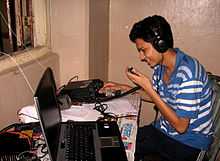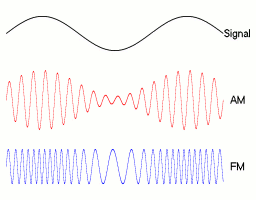Amateur radio

Amateur radio is hobby or pastime enjoyed by many, but with readily available cell phone, it is now usually practiced by an enthusiast rather than a professional, that includes communicating world-wide by two-way radio and can include striving for "DX" receptions that are challenging, usually because of distance.[1]
Obtaining a license
Obtaining a license to operate an amateur radio station requires passing an examination covering technical topics and operating procedures. The exact nature of the assessment varies in each country and by the class of amateur radio license the applicant is seeking. In many countries there are different classes of amateur radio license with different privileges.
Amateur radio licensing by country
United States
License classes
- Technician
- General
- Extra
The items listed above are the exams you must take and pass to be amateur radio operator. They must be taken in that particular order: technician first, then General second, and finally, extra. In the United States, a person may take and pass all three exams in one setting.
United Kingdom
License classes
- Foundation
- Intermediate
- Full
Operating on popular amateur bands

Data on bands and antennas is taken from arrl.org.[2]
- ITU radio band frequency ranges
|
|
Here are standard antenna lengths for 1/2 wavelength long dipole antennas and 1/4 wavelength long vertical antennas for some of the popular amateur bands:
| Band | Frequency type | Frequency range | Antenna length | |
|---|---|---|---|---|
| Dipole | Vertical | |||
| 160m | Medium | 1.8 – 2.0 MHz | 234 ft | 117 ft |
| 80m | High | 3.5 – 4.0 MHz | 117 ft | 58.5 ft |
| 40m | High | 7.0 – 7.3 MHz | 64 ft | 32 ft |
| 30m | High | 10.10 – 10.15 MHz ?? | 46 ft | 23 ft |
| 20m | High | 14.00 – 14.35 MHz ?? | 32 ft | 16 ft |
| 17m | High | 18.07 – 18.17 MHz ?? | 26 ft | 13 ft |
| 15m | High | 21.00 – 21.45 MHz ?? | 22 ft | 11 ft |
| 12m | High | 24.89 – 24.99 MHz ?? | 18 ft | 9 ft |
| 6m | Very high | 50 – 54 MHz | 8 ft | 4 ft |
| 2m | Very high | 144 – 148 MHz | 3 ft | 1.5 ft |
Equipment
Antennas
- Unidirectional propagation
- Omnidirectional propagation
there are two basic types of antennas, antennas that propagate equal in one direction eg."Unidirectional propagation", or antennas that propagate in all directions eg. "omnidirectional propagation"
Readings
Texts
See also
- Internet radio
References
Categories
| |
Subject classification: this is an engineering resource . |
| |
Subject classification: this is a technology resource . |
| |
Educational level: this is a non-formal education resource. |